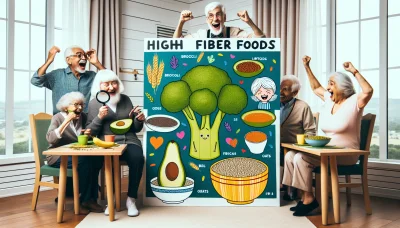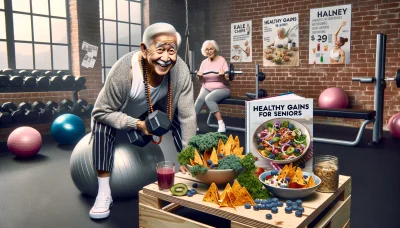Eat stop eat brad pilon Quiz
Test Your Knowledge
Question of
Understanding Eat Stop Eat by Brad Pilon
The Fundamentals of Intermittent Fasting
Eat Stop Eat is a revolutionary approach to dieting that simplifies intermittent fasting. It's not just about skipping meals; it's a structured program designed to boost metabolism and encourage fat loss. Brad Pilon demystifies the process, explaining how occasional 24-hour fasts can lead to sustained weight loss.
The method is straightforward: choose one or two non-consecutive days per week to fast, and eat normally during the rest. This pattern triggers biological responses conducive to weight management. It's a stark contrast to traditional diets, offering a flexible alternative that fits seamlessly into busy lifestyles.
Health Benefits of Fasting Periods
Intermittent fasting goes beyond weight loss; it's linked to numerous health benefits. Research suggests that it can improve cardiovascular health, stabilize blood sugar levels, and enhance brain function. The strategic breaks in eating patterns allow the body to tap into fat stores for energy, which can lead to improved metabolic health.
Eat Stop Eat specifically promotes autophagy, a natural process of cellular cleanup and renewal. By incorporating regular fasting periods, you're not just shedding pounds; you're giving your body a chance to rejuvenate on a cellular level, potentially increasing longevity and vitality.
Common Myths and Misconceptions
Many people harbor misconceptions about intermittent fasting, believing it may cause muscle loss or metabolic slowdown. However, Eat Stop Eat dispels these myths with science-backed evidence. Fasting periods are short enough to preserve muscle mass while being effective in promoting fat loss.
- Muscle Loss Myth: Short-term fasts do not lead to muscle catabolism as long as protein intake is adequate during eating periods.
- Metabolism Slowdown: Intermittent fasting can actually increase metabolic rate by improving hormone function and fat utilization.
- Hunger Misconception: Hunger levels typically normalize after the initial adaptation period, making the diet easier to follow than expected.
- Social Eating Fears: The flexibility of Eat Stop Eat allows for social engagements without compromising diet success.
How Eat Stop Eat Differs from Other Diets
Eat Stop Eat sets itself apart with its simplicity and lack of dietary restrictions during eating periods. Unlike diets that require constant calorie counting or elimination of food groups, this program focuses on when you eat rather than what you eat. This key difference removes much of the stress associated with traditional dieting.
The program also contrasts with continuous calorie restriction by allowing normal eating most days of the week. This approach may prevent the common plateau effect seen in other diets due to its positive impact on leptin levels and metabolic flexibility.
Comparison with Continuous Calorie Restriction
Eat Stop Eat provides an alternative to the daily grind of calorie counting that comes with continuous calorie restriction diets. It offers dieters freedom on non-fasting days, which can lead to better adherence and long-term success. The occasional fasting advocated by Brad Pilon also avoids the potential risk of nutrient deficiencies associated with everyday calorie cuts.
In direct comparison, continuous calorie restriction often leads to a decrease in basal metabolic rate as the body adapts to lower caloric intake. In contrast, intermittent fasting like Eat Stop Eat may boost metabolism through periodic stimulation of fat-burning pathways without compromising muscle tissue or overall energy levels.
Flexibility and Lifestyle Integration
The beauty of Eat Stop Eat lies in its adaptability. Whether you're a busy professional or a full-time parent, this diet molds itself around your schedule. There's no need for special meal prep or timing; it's all about fitting those 24-hour fasts into your existing routine without hassle.
This flexibility extends to workout enthusiasts as well; there's no need for drastic changes in exercise routines. In fact, many find that they perform better on their non-fasting days due to increased energy availability from stored fatsa win-win situation for those looking to maintain an active lifestyle while managing their weight effectively.
The Science Behind Eat Stop Eat
Metabolic Responses to Fasting
Fasting triggers a fascinating cascade of metabolic responses that are essential for human survival. When you fast, your body shifts from using glucose as a primary fuel source to burning stored fat. This metabolic switch not only supports weight loss but also improves metabolic flexibility, which is the body's ability to adapt to varying energy demands efficiently.
During periods of fasting, lower insulin levels facilitate fat breakdown. This process, called lipolysis, leads to the production of ketones, which become an alternative energy source for many tissues, including the brain. These metabolic adaptations are not immediate and typically take several hours after the depletion of glycogen reserves to kick in.
Impact on Insulin Sensitivity
Fasting has a profound impact on insulin sensitivity. As the body breaks down fat for energy during a fast, circulating insulin levels drop significantly. This reduction in insulin promotes increased sensitivity in your cells, meaning they respond better to insulin once you resume eating. Improved insulin sensitivity is linked with a lower risk of type 2 diabetes and can aid in overall metabolic health.
The strategy of Eat Stop Eat may also mitigate issues related to constant high insulin levels such as insulin resistance. By periodically abstaining from food intake, individuals can help their bodies reset and maintain a more sensitive response to insulin, which is critical for regulating blood sugar levels.
Changes in Growth Hormone Levels
Intermittent fasting through methods like Eat Stop Eat can lead to significant increases in growth hormone (GH) levels. GH plays an integral role in muscle preservation and fat metabolism. During fasting periods, GH surges, facilitating fat loss while preserving lean muscle massa paramount concern for many looking to improve body composition.
This elevation in growth hormone not only aids in protecting muscle tissue but also stimulates tissue repair and regeneration throughout the body. The boost in GH during fasting periods underscores one of the potential mechanisms through which Eat Stop Eat may exert its beneficial effects on body composition.
Research on Weight Loss and Muscle Preservation
Eat Stop Eat is grounded in research that suggests intermittent fasting can be an effective approach for weight loss without compromising muscle mass. Studies have shown that intermittent fasting protocols can lead to reductions in body weight and body fat percentage while maintaining muscle strength and endurance capabilities.
One of the key benefits highlighted by researchers is the simplicity of the Eat Stop Eat approach: by reducing calorie intake intermittently rather than continuously, it may be easier to sustain over time compared with traditional dieting methods.
Studies Supporting Eat Stop Eat
- A study published in the "American Journal of Clinical Nutrition" found that alternate-day fasting effectively reduced body weight and fat mass among participants while preserving lean mass.
- Research cited by "Translational Research" indicated that intermittent fasting decreased risk factors for cardiovascular disease along with weight loss benefits.
- The "Journal of Nutritional Biochemistry" suggests that intermittent fasting's benefits extend beyond weight loss, potentially improving brain health and reducing inflammation markers.
- A review article from "Obesity Reviews" concludes that intermittent fasting strategies like Eat Stop Eat could offer psychological benefits due to less restrictive daily eating patterns.
Critiques and Limitations of the Research
Despite promising results, critiques argue that more extensive studies are needed to fully understand long-term implications and efficacy across different populations. Some experts point out that much of the research relies on short-term studies or animal models, which may not translate directly to human subjects over extended periods.
Limited research into gender-specific responses also raises questions about whether recommendations should differ between men and women. Additionally, critics note that adherence rates vary among individuals, suggesting that personal preferences and lifestyles play significant roles in determining the success of intermittent fasting regimens like Eat Stop Eat.
Implementing the Eat Stop Eat Method
Planning Your Fasting Schedule
Embarking on the Eat Stop Eat journey begins with crafting a fasting schedule that aligns seamlessly with your lifestyle. It's all about finding that sweet spot where your fasting days are challenging yet manageable. Start by picking one or two days a week when you're less occupied, allowing your body to ease into the rhythm of fasting without overwhelming stress.
Consistency is key! Once you've chosen your fasting days, stick to them like glue. This consistency helps regulate your body's hunger cues and supports metabolic adaptation. Remember, flexibility within structure is your ally if life throws a curveball, adjust your fasting days but maintain the routine.
Determining Fasting Duration
The core of Eat Stop Eat is the 24-hour fast, a full day where calories take a backseat. Begin your fast after a meal and break it the next day at the same mealtime. It's like pressing pause on eating - simple yet profoundly effective. This duration taps into fat stores and sparks cellular clean-up without nudging you into muscle loss territory.
A 24-hour fast once or twice a week maximizes benefits while keeping any feelings of deprivation at bay. If you're new to fasting, start slow perhaps with a shorter fast and listen to your body's signals as you gradually extend the duration.
Aligning Fasting with Daily Routines
Merge your fasting plan with daily activities for an unobtrusive experience. Busy workdays can be ideal as they distract from hunger pangs and help time fly. On the flip side, avoid scheduling fasts during social events or family dinners to sidestep unnecessary temptation and maintain social harmony.
Nutrition and Diet During Eating Windows
The magic happens in the eating windows this is where you nourish and replenish! Focus on quality foods that fuel recovery and growth. Whole foods, lean proteins, healthy fats, and complex carbs should dominate your plate. Remember, Eat Stop Eat isn't about restriction; it's about balance during non-fasting periods.
Balancing Macronutrients
- Proteins: Lean meats, legumes, and dairy products repair muscles and sustain satiety.
- Fats: Avocados, nuts, and seeds provide essential fatty acids for hormonal balance and cellular health.
- Carbohydrates: Opt for whole grains and vegetables that offer fiber to aid digestion and steady energy release.
- Tips: When breaking your fast, start with something light before moving onto larger meals to prevent gastrointestinal discomfort.
- Mistakes to Avoid: Steer clear of binge eating post-fast; it negates benefits and can lead to an unhealthy cycle.
Importance of Hydration and Micronutrients
H20 is your best friend during both fasting and feasting times! Staying hydrated keeps false hunger at bay and maintains bodily functions at their peak. Aim for water as your main beverage but feel free to include non-caloric drinks like black coffee or herbal tea during fasts for variety.
Micronutrients shouldn't be overshadowed by their macro counterparts. Vitamins, minerals, antioxidants these are the unsung heroes of robust health. Colorful fruits and veggies pack a punch of these vital nutrients ensuring that your body operates like a well-oiled machine!
Overcoming Challenges with Intermittent Fasting
Dealing with Hunger and Cravings
Hunger and cravings can seem like towering hurdles in your intermittent fasting journey. The key is to differentiate between true hunger and habitual eating triggers. Drinking plenty of water or herbal teas can help stave off false hunger signals, keeping you hydrated and focused on your goals.
Cravings are often a sign of nutrient deficiencies or simply psychological. To combat this, ensure your meals are nutrient-dense, focusing on a balance of proteins, healthy fats, and fibers. These foods will not only satisfy you more but also provide sustained energy levels throughout your fast.
Strategies to Manage Appetite
Managing appetite during intermittent fasting is crucial for success. Begin by planning your eating windows around protein-rich foods that promote satiety. Incorporate low-calorie vegetables which you can consume in larger volumes to fill you up without breaking the calorie bank.
A regular exercise routine can also regulate appetite hormones. Even light activities such as walking or stretching can distract from hunger pangs and boost endorphin levels, making fasting periods more manageable.
Psychological Aspects of Hunger
The mind plays a significant role in perceived hunger. Mindful eating practices encourage awareness during meals, which can lead to better satiety cues recognition. It's also pivotal to distinguish between emotional eating and actual hunger; this clarity can prevent unnecessary intake during fasting windows.
Mental fortitude is imperative when fasting. Visualize the health benefits and the progress made thus far to stay motivated. Remember that intermittent fasting is not just a diet but a lifestyle change that requires mental adaptation and resilience.
Social and Lifestyle Considerations
Social engagements don't have to derail your intermittent fasting regimen. With some foresight and planning, you can enjoy these gatherings without compromising your goals. Opt for scheduling social events within your eating window when possible or choose lower-calorie beverages if you must participate during fasting periods.
Lifestyle changes may be necessary when adopting intermittent fasting. This may include altering exercise routines, sleep schedules, and even grocery shopping habits to support your new eating pattern effectively.
Navigating Social Events and Dining Out
- Plan Ahead: Check restaurant menus before attending to select options that align with your dietary needs.
- Communicate: Don't hesitate to inform friends or family about your fasting schedule; they are likely to support you once they understand.
- Focus on Socializing: Shift the focus from food to the company and conversation at social events.
- Flexibility: Allow yourself some flexibility in timing; being too rigid can lead to unnecessary stress.
- Mindful Choices: When dining out, prioritize dishes with lean proteins and vegetables over heavy carbs or sugars.
- Savor Each Bite: If you choose to indulge, do so mindfully, savoring each bite to make the experience more satisfying.
- Beverage Selection: Opt for water or unsweetened teas/coffees if dining out during fasting hours.
Balancing Family Meals and Fasting
Finding harmony between family meals and your intermittent fasting schedule might seem daunting at first glance. Involve your family in meal planningthis way, everyone's needs are considered while maintaining respect for your fasting timetable. You might even inspire others in the household!
Cooking separate meals isn't always necessary; instead, prepare versatile dishes where components can be easily omitted or added depending on who's eating when. This approach keeps mealtime inclusive without breaking anyone's dietary boundaries.
Long-Term Success with Eat Stop Eat
Maintaining Weight Loss Over Time
Achieving lasting weight loss with Eat Stop Eat is not a fleeting fantasyit's a feasible feat! It pivots on establishing a sustainable approach rather than seeking quick fixes. Consistency in your fasting routine marries perfectly with a balanced diet during non-fasting periods, crafting the cornerstone of enduring success.
The beauty of this protocol is its flexibility, adapting to your lifestyle while keeping the calorie count in check. Remember, the journey to weight maintenance is a marathon, not a sprint. Patience and perseverance will be your trusted allies as you embrace this lifestyle change for the long haul.
Setting Realistic Goals and Expectations
Setting realistic goals is like plotting your course on a treasure mapit guides you to the prize of sustainable health. Understand that weight will fluctuate and plateaus are part of the process. By aiming for attainable targets, you anchor your motivation and set yourself up for victory.
Your goals should be as unique as you aretailored to your body, lifestyle, and personal aspirations. This custom fit ensures you're more likely to stick with the program and see tangible results. Realistic expectations act as a compass, keeping you on track towards long-term triumph.
Tracking Progress Without Obsession
Tracking progress strikes the perfect balance between awareness and obsession. It's essential to monitor your journey but equally important not to let the numbers define you. Celebrate non-scale victories like increased energy levels, better fitting clothes, and improved overall well-being.
A healthy tracking mindset focuses on trends over time, not daily fluctuations. Use tools like progress photos or journaling alongside occasional weigh-ins to paint a comprehensive picture of your achievements without becoming captive to the scale.
- Set measurable milestones beyond just weight.
- Use a variety of tracking methods for a holistic view.
- Focus on long-term trends rather than daily changes.
- Celebrate all forms of progress, not just numerical.
- Avoid letting tracking become an unhealthy fixation.
Adapting the Protocol as Life Changes
As life ebbs and flows, so too should your approach to Eat Stop Eat. Whether it's a shift in work schedules or changing family dynamics, remaining adaptable ensures that fasting never feels like an insurmountable challenge but rather an integral part of your evolving routine.
Embrace change by tweaking your fasting windows or incorporating new dietary preferences as needed. This adaptability keeps the protocol fresh and aligned with your current circumstances, ensuring continued commitment without feeling constrained by rigidity.
Incorporating Exercise for Added Benefits
Exercise isn't just an ally; it's a force multiplier when combined with Eat Stop Eat! Engage in physical activities that you enjoybe it lifting weights, hiking, or yogato enhance fat loss and muscle maintenance. This dynamic duo can significantly bolster health benefits and accelerate progress towards your goals.
Consistent exercise during non-fasting periods maximizes energy utilization and contributes to overall well-being. It's not about being perfect; it's about finding harmony between fasting and activity that works seamlessly for you.
Modifying Fasting for Health Conditions
Health conditions require special consideration within any dietary protocol. Consultation with healthcare professionals ensures that any adaptations made to Eat Stop Eat are safe and beneficial for your specific health needs.
Tailoring fasting times or integrating doctor-recommended dietary changes can help manage conditions without derailing your fasting journey. Your health is paramount; thus, modifications should enhance well-being while still aligning with the core principles of Eat Stop Eat.
Common Questions and Expert Advice on Eat Stop Eat
Addressing Concerns about Fasting and Health
The concept of intermittent fasting through the Eat Stop Eat approach often raises eyebrows, with many wondering about its impact on health. Experts clarify that when done correctly, fasting can lead to numerous health benefits, including improved metabolic flexibility and reduced inflammation.
One common misconception is that fasting slows down metabolism. However, research suggests that short-term fasts may actually boost metabolic rate, promoting fat loss while preserving muscle tissue. It's critical to understand the body's adaptive response to fasting for a well-rounded perspective.
Fasting and Metabolic Health Questions
Questions surrounding metabolic health are at the forefront of the fasting conversation. Intermittent fasting strategies like Eat Stop Eat are associated with improved insulin sensitivity and can be a powerful tool in managing blood sugar levels, making it a point of interest for those with concerns about diabetes and metabolic syndrome.
It's essential to consult with healthcare professionals before starting any fasting regimen, especially for individuals with pre-existing health conditions. Personalized guidance ensures that one's approach to Eat Stop Eat aligns with their unique metabolic health needs.
Addressing Nutritional Deficiencies and Concerns
Nutrition is a hot topic when discussing fasting routines. The key is not just about abstaining from food during the fasting period but also ensuring nutrient-dense food intake during eating windows. This balance helps prevent nutritional deficiencies and supports overall well-being.
Experts emphasize the importance of planning meals to include a variety of whole foods rich in vitamins, minerals, and other essential nutrients. Incorporating such foods maximizes the health benefits of the Eat Stop Eat method without compromising nutritional status.
Tips from Long-Term Practitioners
- Start Slowly: Begin with shorter fasting periods and gradually increase as your body adapts.
- Stay Hydrated: Drink plenty of water throughout the day, as hydration is key during fasting.
- Balanced Meals: Focus on balanced meals that include protein, fiber, healthy fats, and carbohydrates to replenish your body post-fast.
- Mindful Eating: Practice mindful eating during your feeding windows to enhance satiety and nutrition absorption.
- Avoid Overeating: Resist the urge to overeat after a fast; this can negate the benefits and lead to discomfort.
- Fitness Routine: Pair your fasting protocol with a consistent fitness routine to complement the benefits of intermittent fasting.
- Social Support: Engage with a community or support group for motivation and sharing experiences.
- Patient Progress: Be patient with your progress; sustainable change takes time.
- Routine Checks: Regularly monitor your health markers to ensure your fasting approach remains beneficial.
Success Stories and Motivation
The transformative tales from long-term practitioners provide a wealth of motivation for newcomers. These anecdotes often highlight significant weight loss achievements, enhanced mental clarity, and an overall sense of empowerment through dietary control.
Motivation can also stem from the simplicity of the programEat Stop Eat doesn't require complicated meal planning or calorie counting, making it an attractive option for those seeking a straightforward path to better health.
Practical Tips for Everyday Adherence
Incorporating Eat Stop Eat into daily life calls for practical strategies that ensure adherence without overwhelming one's lifestyle. Setting up a consistent eating schedule that aligns with personal routines can make adherence feel almost effortless over time.
Focusing on incremental changes rather than immediate perfection allows individuals to adapt more naturally to this way of eating. Flexibility is key; if a particular fast isn't going as planned due to life's unpredictability, it's okay to adjust accordingly without guilt or stress.












